/https://storage.googleapis.com/s3-autonomous-upgrade-3/static/upload/images/new_post/can-you-name-these-executive-office-chair-parts-309-1602745578801.jpg)
9 Executive Office Chair Parts Name (A Complete Guide)
Table of Contents
Choosing your first executive office chair can be exciting. The days of sitting on a living room chair are soon gone and an executive office chair comes with one of the best experiences for posture and productivity. But what if you need to assemble the chair yourself for replacement and don't know what are the parts of an office chair? The following guide addresses the main office chair mechanism parts.
Understanding Desk Chair Diagrams
Taking the time to understand desk chair diagrams isn’t just for repair enthusiasts—it’s a practical skill that can enhance your chair’s functionality and longevity. Here are some key benefits:
- Prolongs Your Chair’s Lifespan
Regular maintenance is easier when you know the specific parts that need attention. For example, spotting wear on the casters or cleaning the tilt mechanism becomes straightforward when you can identify those parts in a diagram. By addressing issues early, you can avoid more costly repairs or replacements.
- Saves Money on Repairs
A detailed desk chair diagram can empower you to handle small repairs yourself instead of relying on professional services. Tasks like replacing casters, tightening screws, or installing a new gas lift cylinder are simple with the guidance of a diagram.
- Improves Comfort and Productivity
When you can fine-tune your chair’s adjustments—such as seat height, tilt tension, or lumbar support—using its diagram, you ensure a better fit for your body. This leads to improved posture, reduced discomfort, and greater focus during work.
- Reduces Environmental Impact
By repairing and maintaining your existing chair instead of discarding it, you contribute to sustainability. Diagrams make it easier to replace individual components rather than throwing away the entire chair.
Incorporating desk chair diagrams into your chair care routine is a smart way to maximize your investment and maintain a healthy workspace. Whether you’re a DIY enthusiast or simply looking to improve your chair’s performance, diagrams provide all the clarity you need to get started.
Office Chair Parts Diagram: A Visual Breakdown
1. Office Chair Base
All executive office chairs come with a base, but the material and design of the base significantly impact its functionality and durability. The base serves as the foundation for stability and allows for movement when equipped with casters.
- Steel Bases
Steel is the most durable material for chair bases, capable of withstanding high pressure and weight. It’s a reliable choice for users seeking maximum stability and longevity. For those who need robust support, consider a heavy-duty office chair with a steel base, designed to handle intensive daily use.
- Aluminum Bases
Aluminum offers a balance between strength and lightweight mobility. It is a preferred material for chairs like the drafting chair, which require flexibility and ease of movement, especially in adjustable-height workspaces. Aluminum bases are durable enough for most users while being easier to reposition than heavier steel alternatives.
- Polypropylene Bases
Polypropylene is a lightweight and cost-effective material used in some chair bases. While it’s convenient for portability, it lacks the strength of steel or aluminum, making it unsuitable for heavier users. If you need a chair designed for higher weight capacities, a 300 lbs office chair with a sturdier metal base would be a better choice for durability and safety.
Each executive office chair comes with a maximum user weight capacity, often detailed in the product description. For heavier users or those needing long-term stability, steel or aluminum bases are the most reliable choices. Lightweight bases, while convenient, may not provide the same level of durability for high-stress environments.
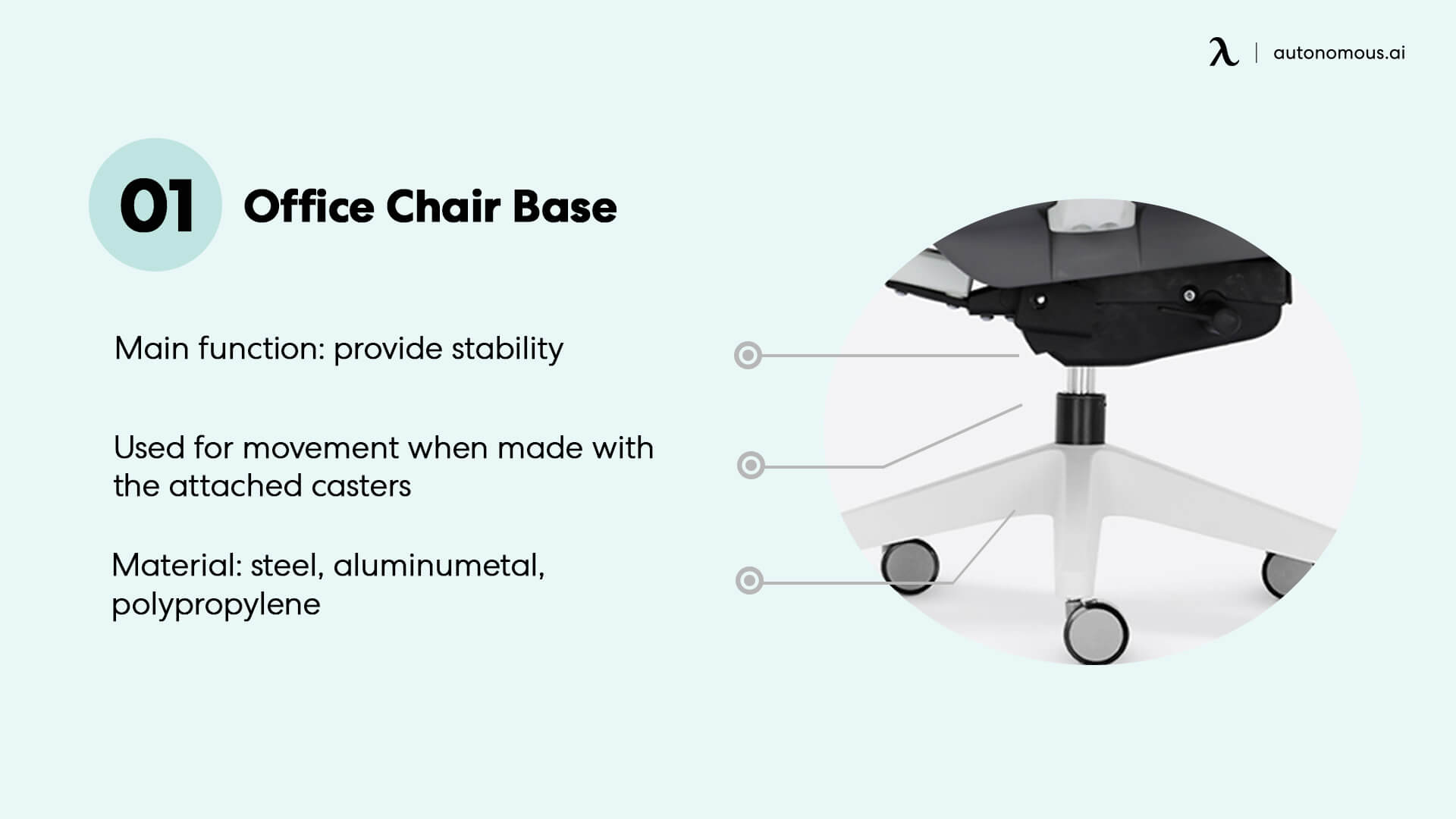
2. Office Chair Mechanism
The mechanism of an office chair is a crucial component that determines its functionality and adjustability. While the design can vary from one manufacturer to another, most office chairs feature mechanisms for vertical and backrest adjustability. Typically located under the seat pan, the mechanism is positioned for easy access while minimizing the risk of accidental adjustments.
For maximum comfort and flexibility, opt for chairs equipped with dynamic mechanisms like the synchro-tilt mechanism, which allows synchronized movement of the seat and backrest for better ergonomic support.
- Tilt Angle Adjustment
The tilt mechanism allows you to recline the chair to a preferred angle, offering a more relaxed seating posture. For troubleshooting or repairs, you can refer to this comprehensive office chair tilt mechanism repair guide.
- Backrest Tilt Lock
This mechanism locks the backrest in a specific position, ensuring stability during work. Learning how to use a chair tilt lock mechanism can help you optimize its function for comfort.
- Backrest Travel Restriction
This feature limits how far the backrest can tilt, allowing you to customize the chair's recline to suit your preferences.
- Height Adjustment
Perhaps the most common mechanism, height adjustment ensures that your feet rest flat on the floor while maintaining proper alignment with your desk.
- Forward Tilt Adjustment
The forward tilt mechanism allows the seat to angle slightly downward, which can improve posture and reduce pressure on your thighs. Learn more about this feature and its benefits in the forward tilt office chair guide.
- Side Tension Adjustment Crank
This adjustment controls the resistance level of the tilt, enabling users to customize the chair's responsiveness based on their weight and preference.
The more adjustable the mechanism, the better it caters to diverse user needs. Features like tilt locks and forward tilts enhance ergonomics, while tension adjustment ensures personalized comfort. When selecting an office chair, prioritize mechanisms that align with your specific requirements to maximize comfort and productivity.
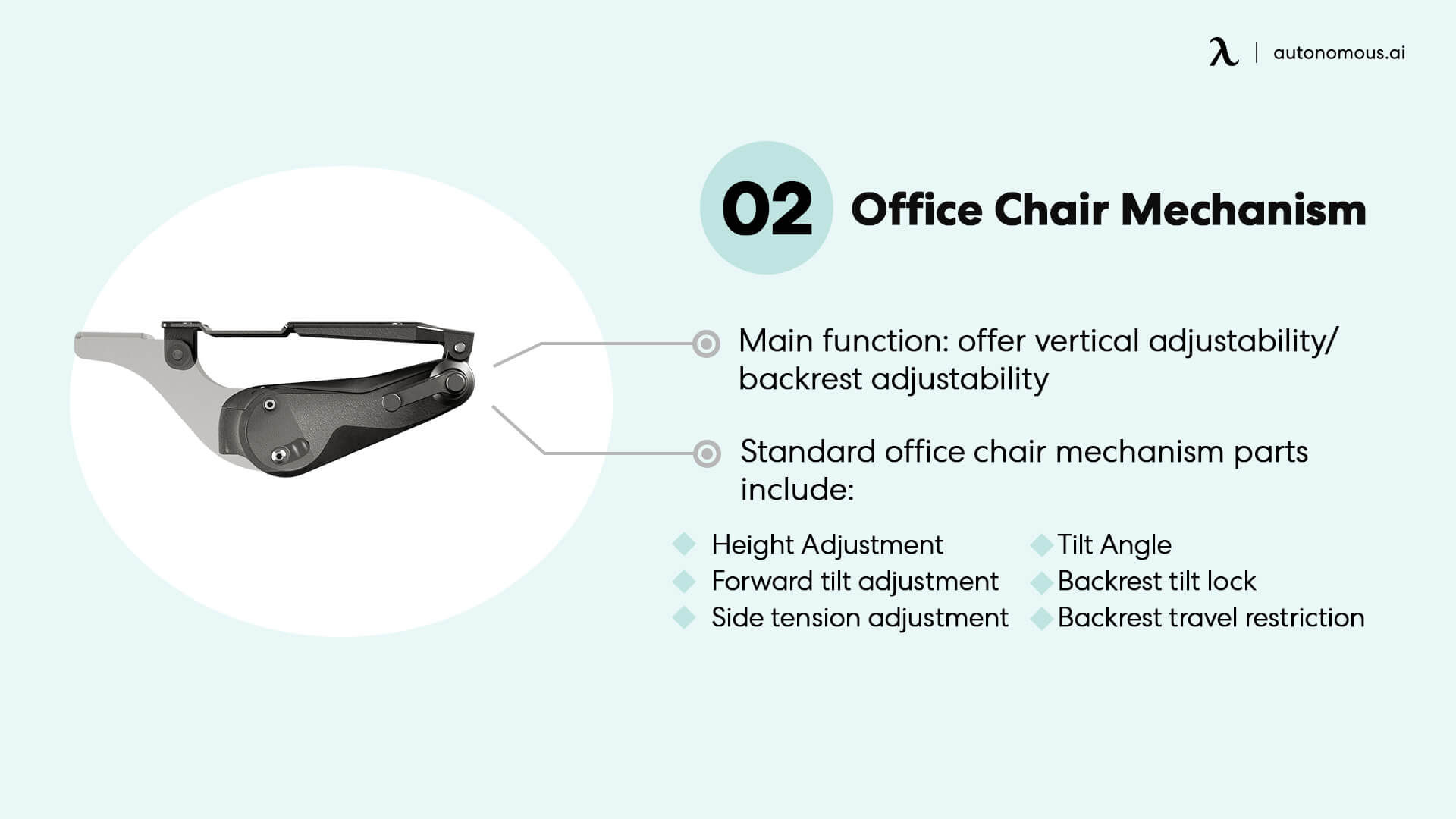
3. Seat pan
The seat pan is a key component of an office chair, directly impacting user comfort and ergonomics. It can feature a basic design or a more advanced ergonomic contour, tailored to meet various user needs. Some chairs even offer adjustable seat pan depth, which accommodates people of different heights and ensures optimal posture.
Seat pans are crafted from various materials, each with unique benefits for comfort and durability. To explore options and find the best fit for your needs, check out this guide on chair seat material.
- Cushioned Comfort
All seat pans include cushioning for added comfort during long sitting sessions. For an upgrade, consider a memory foam seat cushion, which molds to your body for superior pressure relief. Alternatively, a cooling seat cushion can help regulate temperature for a more comfortable experience.
- Adjustable Seat Depth
Some ergonomic chairs allow users to adjust the depth of the seat pan, ensuring proper leg positioning. This ensures that feet remain flat on the ground at a 90-degree angle, which is essential for maintaining circulation and posture.
- Wide Seat Options
For users who prefer more space, a wide seat office chair is an excellent choice. These chairs provide enhanced comfort and flexibility for people with diverse body types or preferences.
- Lightweight and Portable Options
If portability is a priority, a blow-up seat cushion can provide a versatile and convenient solution for extra comfort in any seating arrangement.
An ergonomically designed seat pan ensures comfort, proper posture, and healthy circulation. Choosing the right material, adding supportive cushions, or opting for wider or adjustable designs can significantly enhance your sitting experience. Whether you need extra space, cooling features, or portability, the seat pan plays a critical role in customizing your workspace comfort.
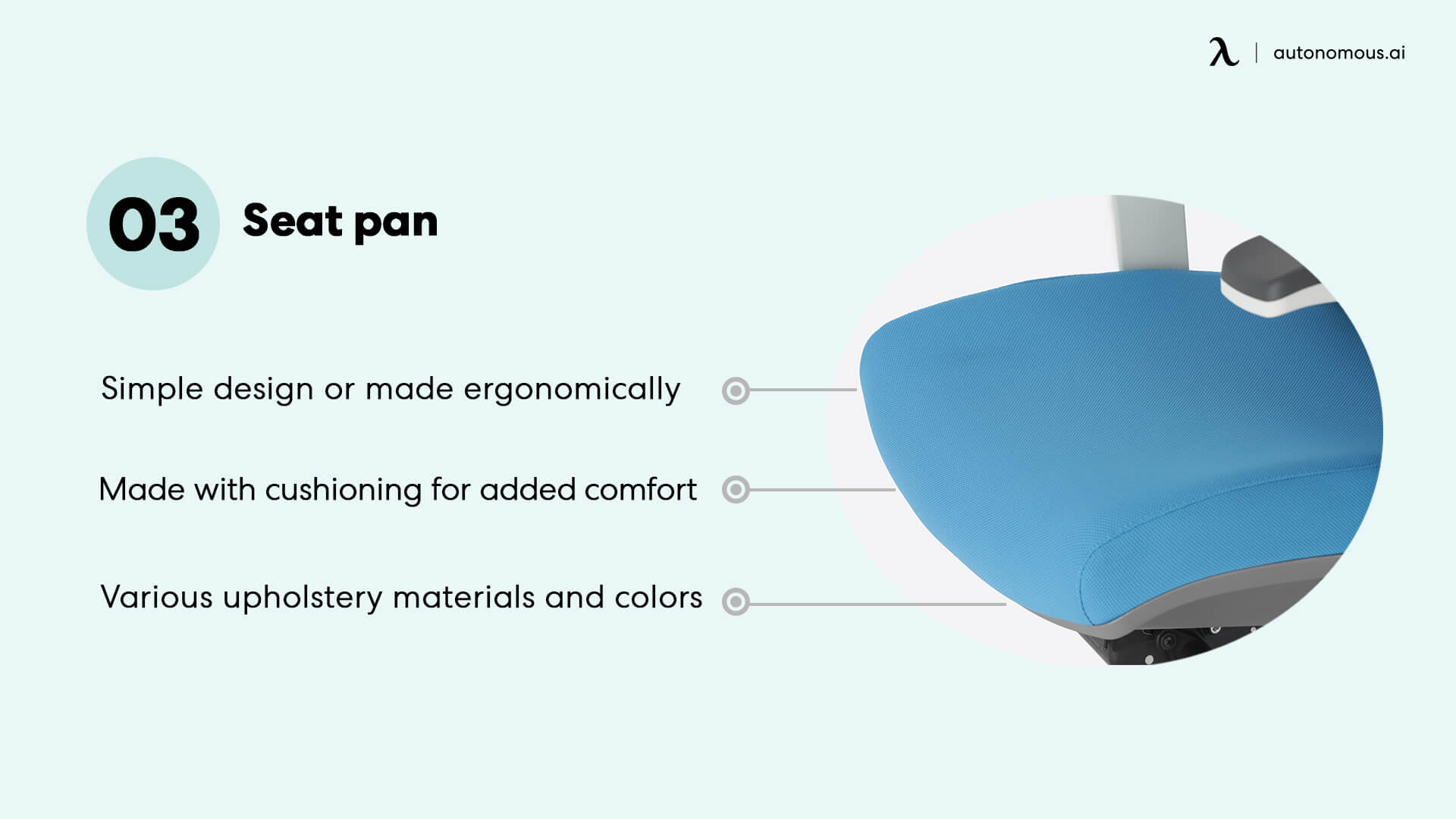
4. Chair cylinder
The chair cylinder is a crucial component that connects the base to the seat pan and provides height adjustability, allowing the chair to accommodate users of various heights. Proper adjustment ensures ergonomic sitting posture, with feet flat on the floor and knees bent at a 90-degree angle. Setting your chair to the standard chair height is essential for maintaining comfort and promoting good circulation.
Most cylinders are equipped with a gas lift mechanism, which allows for smooth and effortless height changes. High-quality executive office chairs feature durable cylinders designed to withstand frequent adjustments. Additionally, many cylinders come with plastic covers to protect the mechanism from dust and debris, ensuring longevity and performance.
If you're curious about how cylinders work or how to replace one, check out this office chair cylinder guide for detailed insights. The cylinder’s durability and functionality are key to maintaining a comfortable and adaptable workspace.
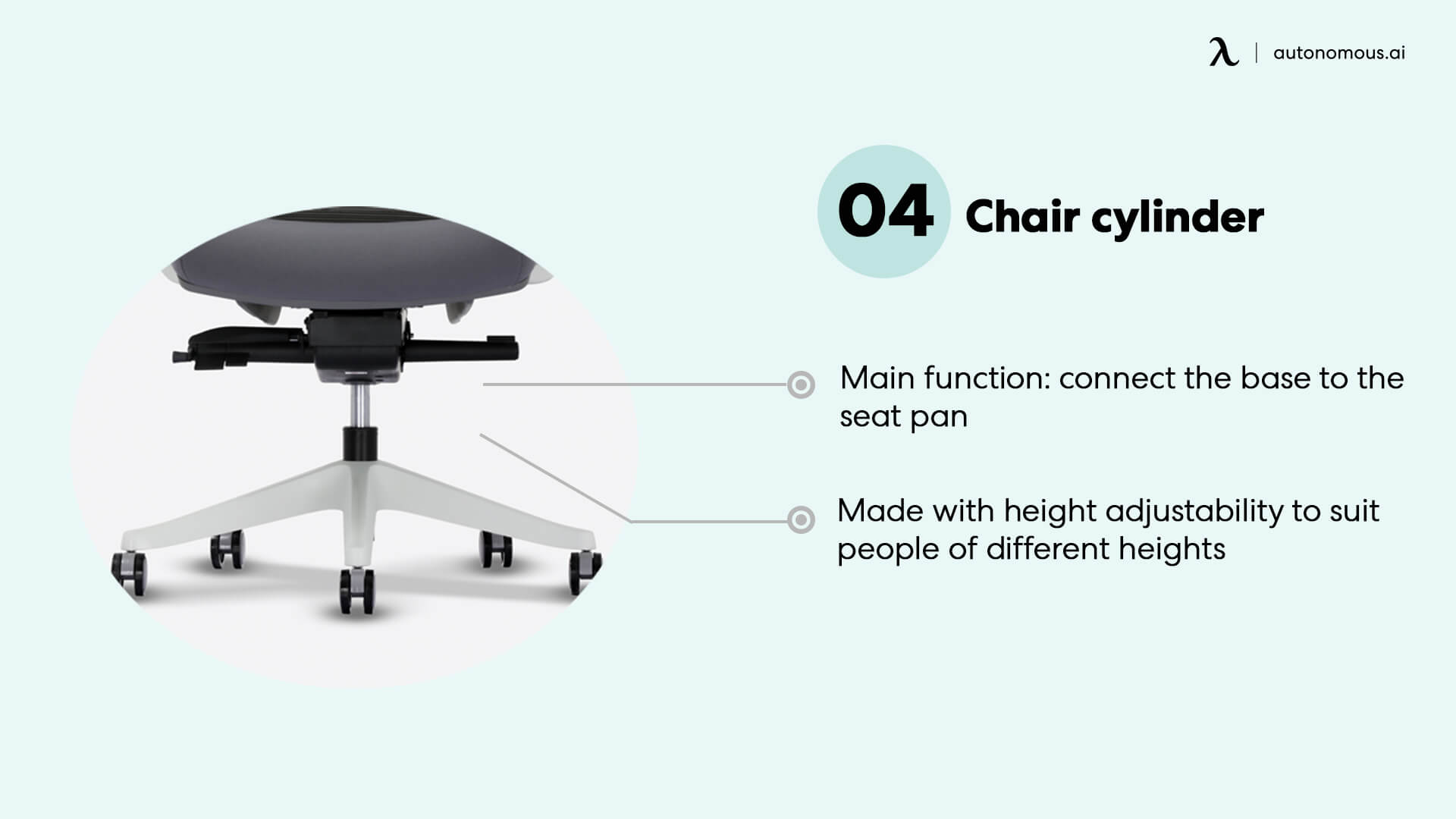
5. Armrests
Armrests are a critical feature of ergonomic office chairs, providing essential support for the arms while typing or writing. Different types of armrests are designed to meet various user needs, balancing functionality and comfort.
- Fixed Armrests
Also known as loop arms, fixed armrests are static and non-adjustable. While they enhance the chair's aesthetics, they may lack the flexibility required for ergonomic support. These are commonly found in small office chairs with arms that prioritize compact design over adjustability.
- T-Armrests
T-armrests are highly popular due to their full height adjustability. They provide excellent support and customization, making them ideal for prolonged use. Advanced options, like those found in 4D armrest office chairs, allow adjustments in height, width, depth, and angle for superior ergonomic functionality.
- Flip-Up Armrests
Flip-up armrests offer enhanced mobility by allowing users to easily move them out of the way. This feature is particularly useful for individuals who frequently leave their desks or prefer a less restrictive workspace. Explore the best options for an office chair with flip-up arms to maximize flexibility.
- Adjustable Armrests
Adjustable armrests are a must-have for ergonomic office chairs, as they allow users to customize the height and position to suit their individual needs. Check out an office chair with adjustable arms for an optimal balance of comfort and support.
- No Armrests
For those who prefer a minimalist design or need more space, an armless office chair is an excellent alternative. These chairs provide more freedom of movement and are ideal for compact workstations.
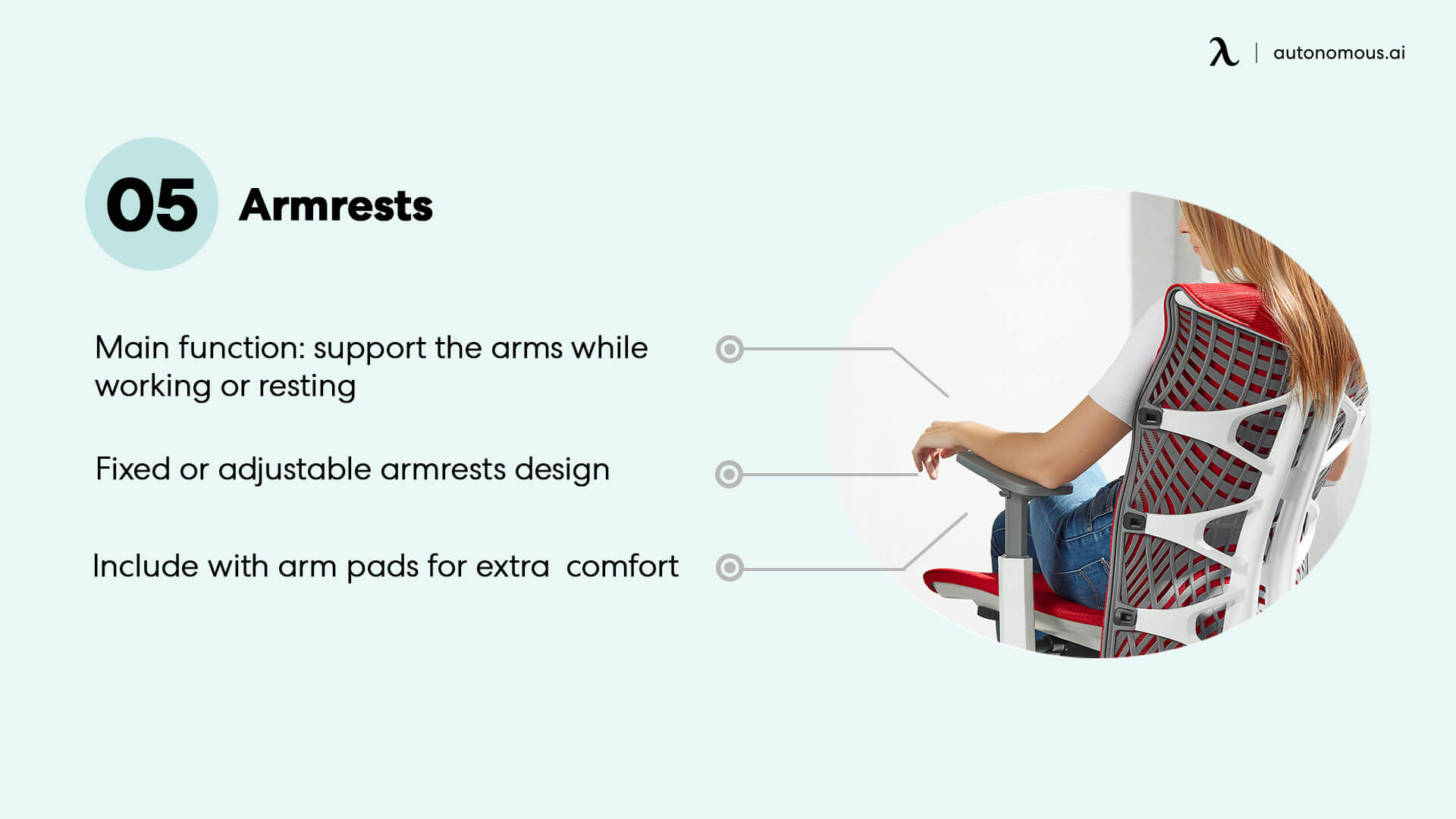
6. Lumbar support system
The lumbar support system is a crucial feature of an office chair’s backrest, designed to maintain the natural curve of the lower spine and promote proper posture. By supporting the lower back, it helps reduce slouching and alleviates strain during prolonged sitting. Whether integrated or adjustable, office chairs with lumbar support are essential for maintaining a healthy working position at the desk.
Adjustable lumbar support systems are particularly beneficial as they can be moved up or down to align with the user’s lower back, catering to various heights and specific ergonomic needs. This customization not only improves posture but also provides relief for individuals experiencing back pain. For the best results, understanding where lumbar support should be positioned ensures maximum comfort and efficiency.
For those seeking tailored solutions, an ergonomic office chair with lumbar support or an ergonomic chair for back pain can significantly enhance comfort and productivity by offering targeted support and adjustability.
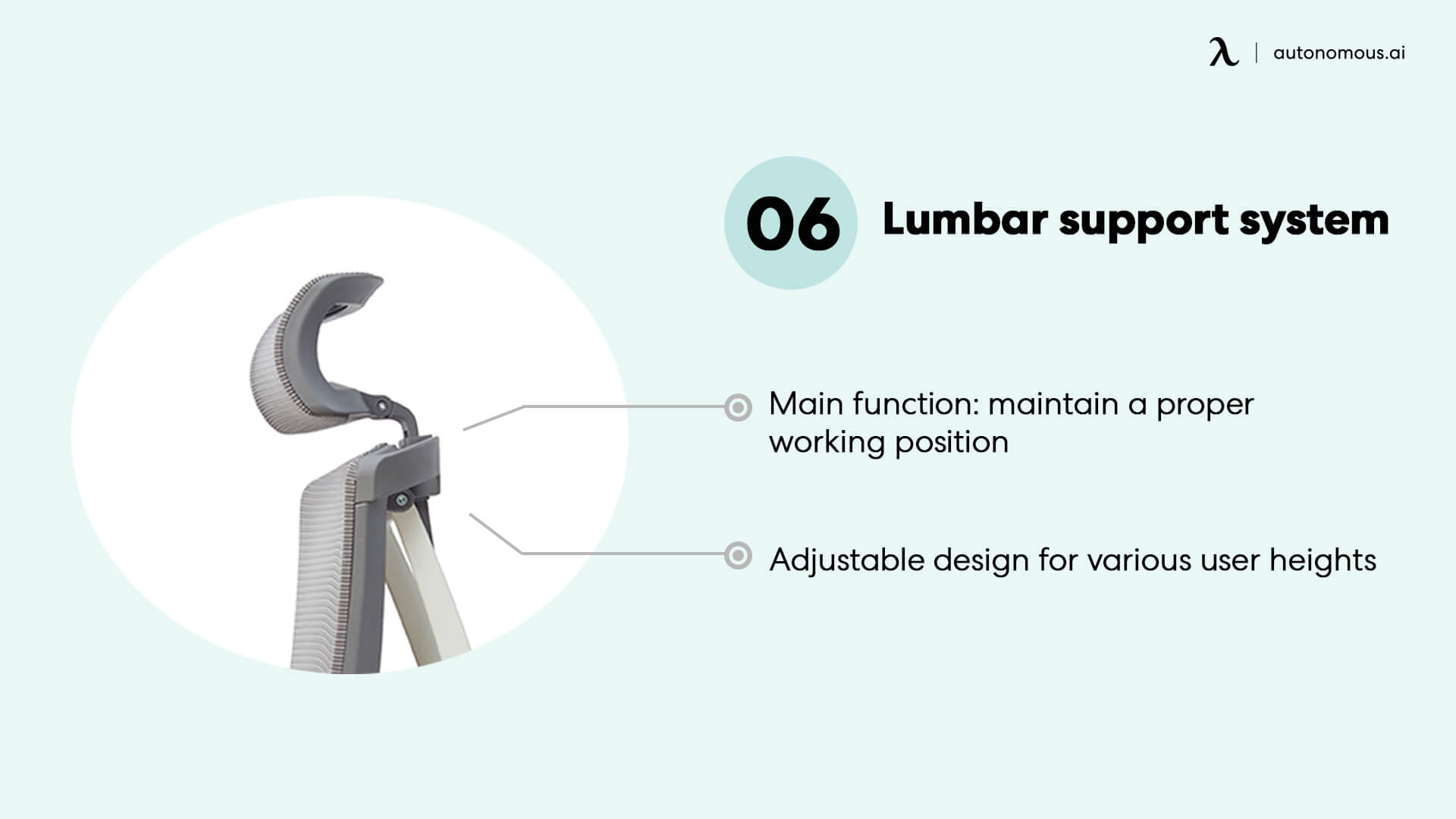
7. Office chair headrest
The headrest is a critical feature of some executive office chairs, designed to provide support for the head and neck. Not all chairs include a headrest, but those that do can significantly enhance comfort and reduce neck pain. There are two common types of headrests in office chairs:
- Built-in Headrests – Integrated into the backrest and provide a fixed position for support.
- Adjustable or Removable Headrests – Attached on top of the backrest, allowing users to adjust the height or remove them altogether for a customized experience.
The primary purpose of a headrest is to alleviate neck strain by supporting the head in a neutral position. For proper ergonomics, it’s crucial to understand where a headrest should be positioned to ensure maximum effectiveness and comfort.
A mesh office chair with headrest offers breathable comfort and ergonomic support. These chairs are ideal for long working hours, providing ventilation for the back and targeted support for the neck and head.
For users seeking neck pain relief, an office chair with headrest is designed to promote proper alignment and reduce strain. This type of chair is especially beneficial for individuals who experience neck pain from sitting at a desk during prolonged work sessions.
For added comfort, a reclining chair with a headrest can provide adjustable angles that support the neck and reduce tension. Learn more about the best office chairs for neck pain and how they improve posture while working.
Do You Need a Headrest?
Whether you need a headrest depends on your specific requirements. Some users may benefit greatly, particularly if they frequently experience neck discomfort. Learn more about do I need a headrest on my office chair for your workspace setup and how it can enhance ergonomics.
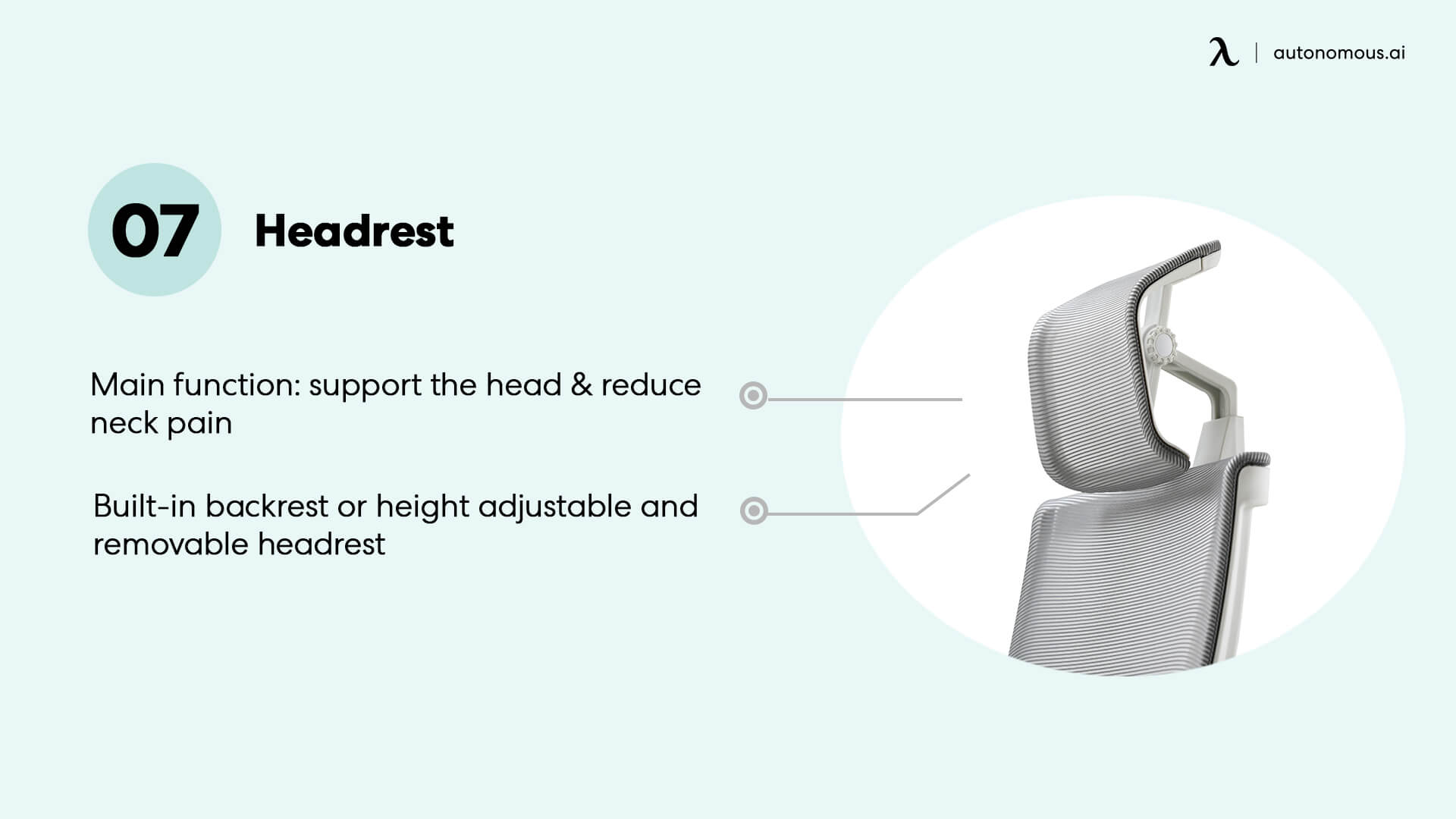
8. Backrest
The backrest of an executive office chair integrates key elements like the lumbar support system, headrest, and upper back support, making it essential for promoting proper posture and spinal health. Backrests can either be fixed or adjustable to allow recline, offering flexibility to suit individual preferences and working styles.
The backrest plays a crucial role in maintaining spinal alignment, ensuring users remain in a comfortable and supportive position throughout the day. Fully adjustable backrests that recline are ideal for reducing lower back pressure during long sitting sessions. Adjustable designs allow users to shift positions, preventing stiffness and fatigue. For users dealing with discomfort, the best office chair for upper back pain or the best chair for lower back pain can provide significant relief, ensuring proper support where it's needed most.
The material of the backrest also impacts its effectiveness and comfort:
- Mesh Backrests provide enhanced ventilation, making them ideal for long hours in warmer environments. Explore options like a high back office chair to combine breathable materials with extended support.
- Leather Backrests offer a premium look and feel, often found in high-end executive chairs.
- Rubber or Plastic Backrests are common in affordable models, providing basic support without the added benefits of premium materials.
Some backrests work in tandem with supportive accessories, such as a seat cushion for back pain, to further enhance comfort and reduce strain on the spine. For users seeking unconventional options, a backless chair can encourage active sitting by engaging the core muscles. While not suitable for prolonged use, it’s a good complementary choice for improving posture.
The backrest is the backbone of any ergonomic office chair, dictating the position of the spine and providing essential support for long work hours. Whether you prioritize flexibility, premium materials, or targeted pain relief, selecting the right backrest design can significantly improve your comfort and productivity.
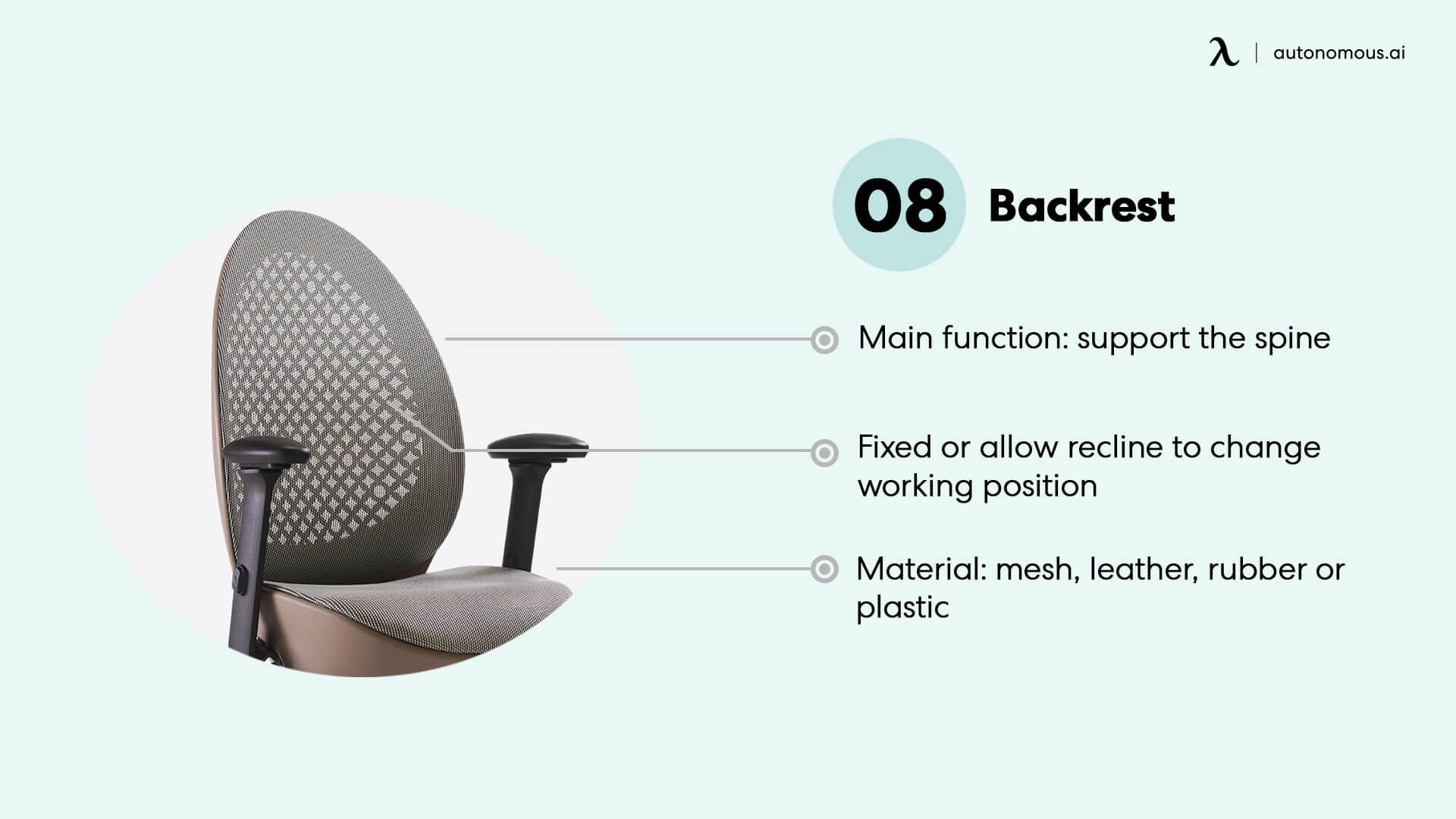
9. Casters/ Wheels
Casters are attached to the base of an office chair, providing mobility and convenience by allowing the chair to roll across the floor without needing to be lifted. While often referred to simply as wheels, casters consist of both the wheel itself and the frame that holds and pivots it, enabling smooth and controlled movement.
- Soft Casters: Soft casters are designed for use on hard surfaces like wood or tile. Their softer material prevents scratches and enhances grip, ensuring smooth movement without damaging the floor.
- Hard Casters: Hard casters are ideal for carpeted floors, providing the necessary strength to roll over fabric surfaces without snagging or resistance.
For a unique and ergonomic seating option, consider a criss cross chair with wheels, which combines mobility with support for cross-legged sitting.
Over time, casters may need to be replaced due to wear or to accommodate a different type of flooring. Replacing them is a straightforward process, and knowing how to do so can extend the lifespan of your chair. Follow this step-by-step guide for office chair wheel replacement to ensure your chair remains functional and easy to maneuver.
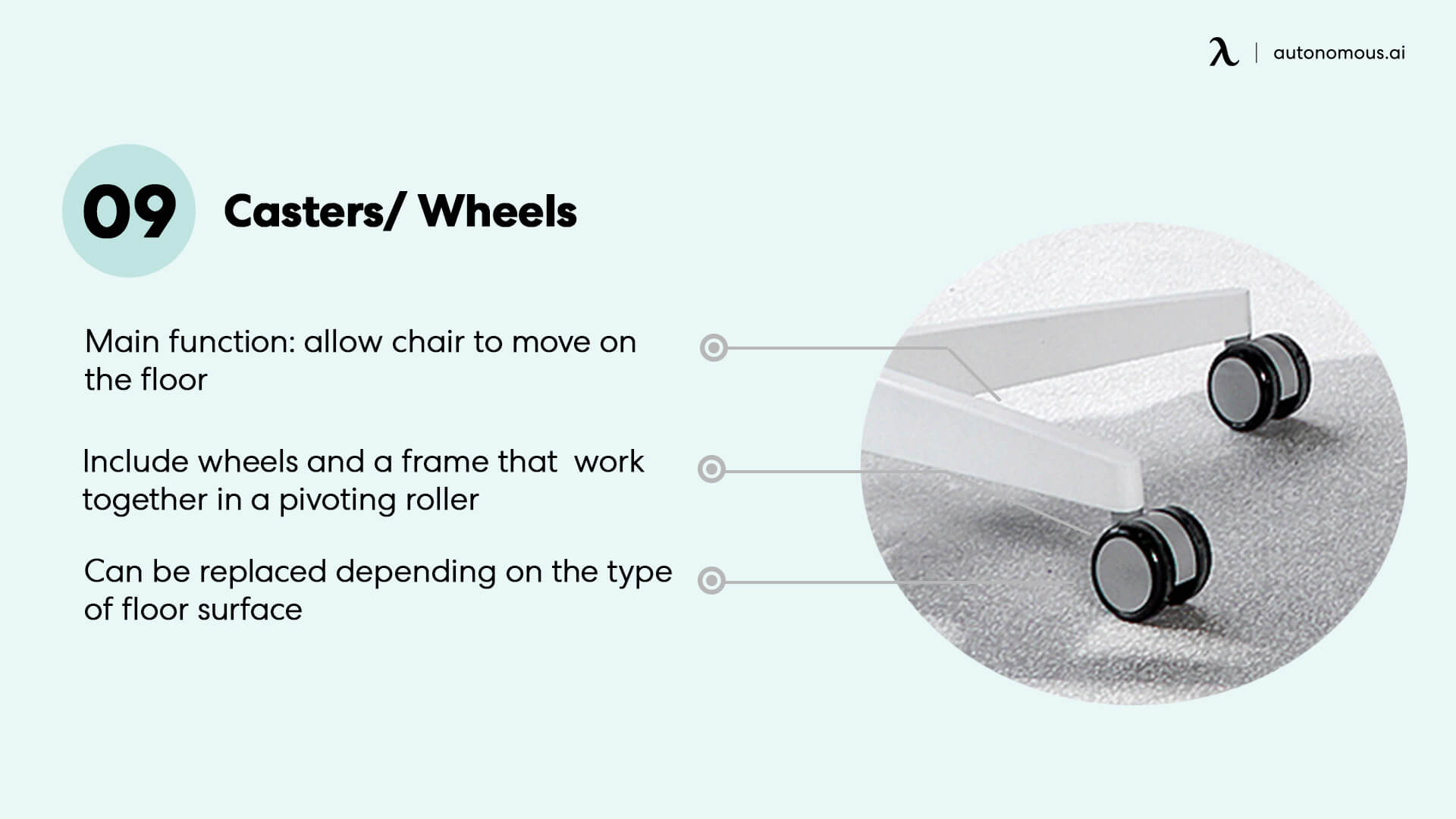
Office Chair Materials
These are the basic components of an executive office chair. Of course, they can also vary according to each design. At the same time, some of the main differences can also be made by the materials of an office chair.
- Mesh chairs
Mesh chairs are a popular choice due to their breathability and durability. Often used on the backrest and seat pan, mesh provides proper ventilation, making it ideal for long hours of sitting. Contrary to popular belief, mesh is both lightweight and robust when made with high-quality materials. For those considering this option, a mesh chair offers an ergonomic and breathable solution. Maintenance is simple when you follow the best way to clean a mesh office chair to keep it fresh and functional. If you are debating options, comparisons like mesh vs leather office chair or mesh vs upholstered office chair can help determine the right fit for your workspace.
- Leather chairs
Leather chairs, often inspired by classic designs, bring an air of sophistication to any office. While genuine leather chairs are rare due to their high cost, they remain a luxurious choice for vintage or executive environments. Affordable alternatives like faux leather desk chairs or vegan leather chairs offer similar aesthetics without the premium price. For those seeking the finest quality, a genuine leather office chair provides unmatched durability and style. If you already own a leather chair and want to extend its life, you can reupholster a leather chair to refresh its appearance and functionality. A leather office chair is an excellent choice for both modern and traditional setups, offering a sleek and professional finish.
- Fabric chairs
Fabric chairs are a versatile option, allowing for a high degree of customization in terms of color and texture. This adaptability makes fabric chairs a preferred choice for integrating into diverse office aesthetics. They are soft to the touch, providing a warmer feel compared to leather or mesh. A fabric high back office chair combines ergonomic support with a modern look, making it a popular choice for contemporary workspaces. If you are evaluating materials for gaming or work, comparing a fabric vs leather gaming chair can help you decide based on comfort and style preferences.
- Vinyl chairs
Vinyl chairs offer a cost-effective alternative to leather, delivering a similar aesthetic at a fraction of the price. Used on both the seat pan and backrest, vinyl is easy to clean and maintain, making it ideal for high-traffic or shared office environments. While not as luxurious as leather, vinyl provides practicality and durability, fitting well into various settings.
Common Issues and Office Chair Schematic
Office chairs are essential for comfort and productivity, but over time, they can develop problems that hinder their performance. A well-labeled office chair schematic is a valuable tool for identifying and addressing these issues. Let’s explore some common problems and how to pinpoint the source using a schematic.
- Squeaky Casters or Stuck Wheels
Over time, debris and wear can cause the casters to become noisy or stuck, making it difficult to move the chair smoothly. By identifying the exact placement of the casters and their attachment points, a schematic can guide you in removing, cleaning, or replacing the wheels.
- Faulty Gas Lift Cylinder
The chair sinks or fails to adjust properly, often due to a worn-out gas lift cylinder. A gas lift cylinder diagram shows where the cylinder connects to the base and seat, making replacement straightforward.
- Loose or Wobbly Armrests
Armrests can loosen with regular use or become unstable due to worn screws or connectors. The diagram reveals the armrest’s connection to the seat frame, enabling you to tighten screws or replace damaged parts.
- Malfunctioning Tilt or Recline Mechanism
The tilt function may stick, or the backrest may fail to recline properly. The mechanism’s location and attachment points are clearly shown, helping you inspect for loose parts or broken springs.
By using an office chair schematic, you can save time troubleshooting and ensure you’re targeting the right area for repair. Always consult the chair’s manual for specific instructions to avoid causing further damage.
How to Replace Executive Office Chair Parts
Regardless of the chosen materials, replacing the executive office chair parts should not be too complicated. For this purpose, individual users or businesses need to contact the manufacturer of the chairs to establish if and where the replacement parts can be purchased. Replacing them should be easy, especially for small parts such as casters. Replacing larger pieces such as the cylinder might need some professional help.
FAQs
Those who have further questions on executive office chair parts can look at the following questions to troubleshoot particular issues.
1. My chair has a broken component, can I still use it?
Having a broken component in an executive office chair is common. Although the durability of the components should be a priority for the manufacturer, some parts can break-in time. Depending on the damaged component and on the policy of the manufacturer, the chair could be fixed and used again. Contacting the manufacturer or the seller directly is recommended for this issue.
2. Why does my office chair sink?
An executive office chair can come with adjustable height, which is actually based on the main cylinder. Adjusting this cylinder also adjusts the chair’s height. This should only be the case when auctioning a lever and the chair should never sink on its own. If the chair is sinking while you sit on it, this might be an indication of a faulty cylinder. Replacing the cylinder might require users to contact the manufacturer and choose a replacement part or have the manufacturer replace the cylinder if the chair is still under warranty.
3. Is it OK for my executive office chair to wobble?
An executive office chair should not wobble. While some movement can be seen due to a large number of the component which comes together in a chair, it is not normal to have a chair wobble. The best way to test if the office chair truly wobbles is simply by placing it on a perfectly flat surface. Jiggling the chair diagnoses the wobble. If the chair wobbles, it can be an indication that it has not been installed correctly. At the same time, the wobble can come as a result of a lower material’s tolerance, which is seen in time, with older office chairs.
4. What can I do if my office chair won’t lead back anymore?
The reclining mechanism of the chair should be durable in most cases. But if it is stuck in a position, it should be replaced with a new mechanism which would allow the backrest to function as intended.
5. Why does my office chair hurt my back?
If your chair is hurting your back, it can signal various problems. Poor lumbar support can be one of the issues which lead to back pain. Having the armrests too high or too low can also impact the shoulders, the neck, and the back. Lacking an ergonomic design can also come with back pain. To ensure the office chair is in good working condition, all users should read the product’s manual thoroughly to understand how to use it for the best results, as recommended by the manufacturer.
6. Why does my office chair stink?
If you have a stinky chair, it might be the sign it needs a new seat pad or a reupholstered backrest. One of the best ways to prevent stinky chairs is to use mesh materials which allow proper ventilation and which prevent users from sweating while sitting. Another way to prevent stinky office chairs is to maintain proper ventilation and airflow in the office.
Final considerations
Most executive office chairs come pre-installed. Some might need to be installed by the user but this should not take more than a few minutes. All the office chair mechanism parts are usually intact. However, when a part needs to be replaced, it is recommended to know the part and contact the seller or manufacturer as soon as possible. And if you're looking for a new office chair or other ergonomic accessories, standing desk or anti fatigue mat,... check for Autonomous products right away.

Stay connected with us!
Subscribe to our weekly updates to stay in the loop about our latest innovations and community news!
Interested in a Link Placement?
.svg)
.svg)



/https://storage.googleapis.com/s3-autonomous-upgrade-3/production/ecm/230914/bulk-order-sep-2023-720x1200-CTA-min.jpg)

/https://storage.googleapis.com/s3-autonomous-upgrade-3/production/ecm/230824/EthanJohnson-ffebe8b4-4650-46f9-a3b3-ed980acaad86.jpg)